Chapter 16: Capital structure
Chapter learning objectives
Upon completion of this chapter you will be able to:
- define, calculate and explain the significance to a company's financial position and financial risk of its level of the following ratios:
- operating gearing
- financial gearing
- interest gearing
- define company value
- explain the relationship between company value and cost of capital
- explain the traditional view of capital structure theory
- explain the underlying assumptions of the traditional view of capital structure theory
- interpret a graph demonstrating the traditional view of capital structure theory
- explain the assumptions of a perfect capital market
- describe the views and assumptions of Miller and Modigliani (M&M) on capital structure without corporate taxes
- interpret a graph demonstrating the views of M&M on capital structure without corporate taxes
- describe the views and assumptions of M&M on capital structure with corporate taxes
- interpret a graph demonstrating the views of M&M on capital structure with corporate taxes
- identify a range of capital market imperfections and describe their impact on the views of M&M on capital structure
- explain the relevance of pecking order theory to the selection of sources of finance
- discuss the circumstances under which weighted average cost of capital (WACC) can be used in investment appraisal
- identify in a scenario question whether WACC is appropriate for use by a company
- discuss the advantages of the capital asset pricing model (CAPM) over WACC in determining a project-specific cost of capital
- identify in a scenario where CAPM may be suitable to determine a project-specific cost of equity capital
- apply CAPM in calculating a project-specific discount rate.
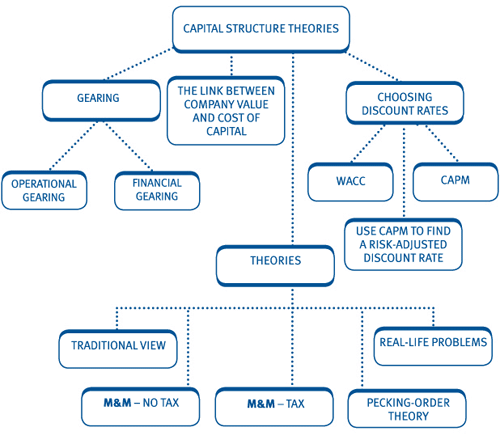
1 Operating gearing
 Operating gearing is a measure of the extent to which a firm'soperating costs are fixed rather than variable as this affects the levelof business risk in the firm. Operating gearing can be measured in anumber of different ways, including:
Operating gearing is a measure of the extent to which a firm'soperating costs are fixed rather than variable as this affects the levelof business risk in the firm. Operating gearing can be measured in anumber of different ways, including:

 Firms with a high proportion of fixed costs in their cost structures are known as having 'high operating gearing'.
Firms with a high proportion of fixed costs in their cost structures are known as having 'high operating gearing'.
Thus if the sales of a company vary:
The greater the operating gearing the greater the EBIT variability.
The level of operating gearing will be largely a result of the industry in which the firm operates.

 Test your understanding 1 – Operating gearing
Test your understanding 1 – Operating gearing
Two firms have the following cost structures:
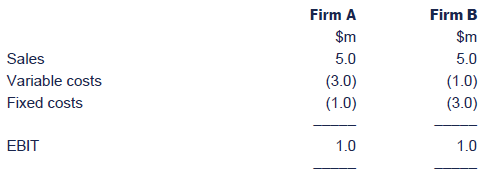
What is the level of operating gearing in each and what would be the impact on each of a 10% increase in sales?

2 Financial gearing
The financial gearing ratios
 Financial gearing is a measure of the extent to which debt is used in the capital structure.
Financial gearing is a measure of the extent to which debt is used in the capital structure.
Note that preference shares are usually treated as debt (see chapter on sources of finance for logic).
It can be measured in a number of ways:
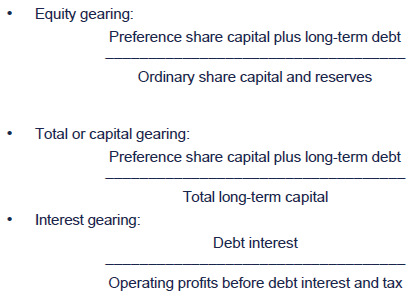
NB Since preference shares are treated as debt finance, preference dividends are treated as debt interest in this ratio.
All three ratios measure the same thing, but
- for comparison purposes, the same ratio must be used consistently
- capital gearing is used more often than equity gearing
- interest gearing is an income statement measure rather than a financial position statement one. It considers the percentage of the operating profit absorbed by interest payments on borrowings and as a result measures the impact of gearing on profits. It is more normally seen in its inverse form as the interest cover ratio (see below).

 Test your understanding 2 – Capital and equity gearing
Test your understanding 2 – Capital and equity gearing
Statement of financial position for Redknapp Co

Equity and liabilities:

Calculate the equity gearing and capital gearing of the business.

Book or market values
 The ratios can be calculated on either book or market values of debt and equity.
The ratios can be calculated on either book or market values of debt and equity.
There are arguments in favour of both approaches:
Market values:
- are more relevant to the level of investment made
- represent the opportunity cost of the investment made
- are consistent with the way investors measure debt and equity.
Book values:
- are how imposed gearing restrictions are often expressed
- are not subject to sudden change due to market factors
- are readily available.
Impact of financial gearing
Where two companies have the same level of variability in earnings,the company with the higher level of financial gearing will haveincreased variability of returns to shareholders.

 Test your understanding 3 – The impact of financial gearing
Test your understanding 3 – The impact of financial gearing
Calculate the impact on Firm C of a 10% fall in sales and comment on your results:
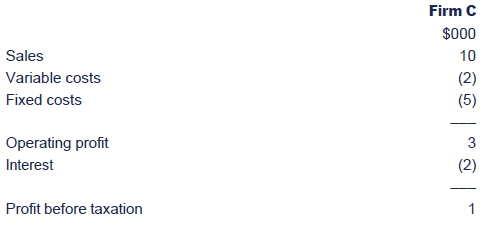

It is a financial manager's role to balance these different riskfactors to ensure that the overall risk faced by equity investors isacceptable. It is the level of overall risk that will determine the rateof return an equity investor demands.
In reality, there is little that a financial manager can do toalter the business risk and there may only be limited opportunities foraltering operating gearing. It is therefore the risk associated with howthe company is financed that is most easily controlled.
A firm must consider the volatility it cannot avoid and ensure thatthe gearing decisions it takes avoid increasing risks to unacceptablelevels.
3 An optimal capital structure? – company value and the cost of capital
 The objective of management is to maximise shareholder wealth. Ifaltering the gearing ratio (the extent to which debt is used in thefinance structure) could increase wealth, then finance managers wouldhave a duty to do so.
The objective of management is to maximise shareholder wealth. Ifaltering the gearing ratio (the extent to which debt is used in thefinance structure) could increase wealth, then finance managers wouldhave a duty to do so.
Is it possible to increase shareholder wealth by changing the gearing ratio/level?
- The market value (MV) of a company is the sum of the MVs of its various forms of finance. This equates to the MV of the company's equity plus debt.
- The MV of each type of finance is known to be the PV of the returns to the investor, discounted at their required rate of return.
- If a company distributes all its earnings, it follows that the total MV of the company equates to the present value (PV) of the future cash flows available to investors, discounted at their overall required return or WACC.
If you can reduce the WACC, this results in a higher MV/net presentvalue (NPV) of the company and therefore an increase in shareholderwealth as they own the company:
The WACC is a weighted average of the various sources of finance used by the company.
Debt is cheaper than equity:
- lower risk
- tax relief on interest
but:
increasing levels of debt make equity more risky:
- fixed commitment paid before equity – finance risk
- so increasing financial gearing increases the cost of equity and that would increase the WACC.
Various theories have attempted to answer the question:
4 The traditional view of capital structure
Also known as the intuitive view, the traditional view has notheoretical basis but common sense. Taxation is ignored in thetraditional view.
At low levels of gearing:
Equity holders perceive risk as unchanged so the increase in the proportion of cheaper debt will lower the WACC
At higher levels of gearing:
Equity holders see increased volatility of returns as debt interest must be paid first. This leads to:
- increased financial risk
- increase in Ke outweighs the extra (cheap) debt being introduced
- WACC starts to rise.
At very high levels of gearing:
Serious bankruptcy risk worries equity and debt holders alike Ke and Kd rise WACC rises further.
This can be shown diagrammatically:
where:
Ke is the cost of equity
Kd is the cost of debt
Conclusion
There is an optimal level of gearing – point X. At point X theoverall return required by investors (debt and equity) is minimised. Itfollows that at this point the combined market value of the firm's debtand equity securities will also be maximised.
Assumptions underpinning the traditional view
- No taxation
- The company pays out all its earnings as dividends
- The earnings of the company are expected to remain constant in perpetuity
- Business risk is constant
- The gearing of a company can be changed immediately by issuing debt to repurchase shares or vice versa. That is to say the capital employed in the business is constant.
- The are no transaction costs for issues
Implication for finance
Company should gear up until it reaches optimal point and then raise a mix of finance to maintain this level of gearing.
Problem
There is no method, apart from trial and error,available to locate the optimal point.

 The traditional view of capital structure
The traditional view of capital structure
As an organisation introduces debt into its capital structure, theWACC will fall because initially the benefit of cheap debt finance morethan outweighs any increases in the cost of equity required tocompensate equity holders for higher financial risk.
As gearing continues to increase the equity holders will ask forincreasingly higher returns and eventually this increase will start tooutweigh the benefit of cheap debt finance, and the WACC will rise.
At extreme levels of gearing the cost of debt will also start torise (as debt holders become worried about the security of their loans),shareholders will continue to increase their required return and thiswill contribute to a sharply increasing WACC.
As a company begins to 'suffer' from high gearing, problems such asfewer assets left to offer for security on new loans, and restrictiveterms from investors, become more likely. Key staff leave to avoid beingtainted by a failed company. Uncertainties are placed in the minds ofcustomers and suppliers, which may result in lost sales and moreexpensive trading terms. Shareholders refuse to invest new funds forpositive NPV projects, as they do not wish 'to throw good money afterbad'.
If a bankruptcy situation finally occurs, the assets may be soldoff quickly and cheaply. A large proportion of management time is spent'fire fighting', i.e. focusing on short-term cash flow rather thanlong-term shareholder wealth.
The traditional view therefore claims that there is an optimalcapital structure where WACC is at a minimum. This is represented bypoint X on the above diagram.
At point X the overall return required by investors (debt andequity) is minimised. It follows that at this point the combined MV ofthe firm's debt and equity securities will also be maximised.
(If investors are offered the same $ return but the % return theyrequire has fallen market pressures will make the value of thesecurities rise.)
The main support for the traditional view is that it simply accords with 'common sense' and until 1958 it was not questioned.

To address this problem two economists attempted to find the optimal point in 1958.
5 Modigliani & Miller (M&M) – 1958 theory with no taxation
M&M argued that:
- as investors are rational, the required return of equity is directly proportional to the increase in gearing. There is thus a linear relationship between Ke and gearing (measured as D/E)
- the increase in Ke exactly offsets the benefit of the cheaper debt finance and therefore the WACC remains unchanged.
Conclusion
- The WACC and therefore the value of the firm are unaffected by changes in gearing levels and gearing is irrelevant.
- Implication for finance:
- choice of finance is irrelevant to shareholder wealth: company can use any mix of funds
- this can be demonstrated on the following diagram:

Assumptions underpinning M&M's theory
- No taxation
- Perfect capital markets where investors have the same information, upon which they react rationally.
- No transaction costs
- Debt is risk free
 A key part of M&M's theories are the assumptions. Ensure you can discuss them.
A key part of M&M's theories are the assumptions. Ensure you can discuss them.

 Modigliani & Miller: no taxes
Modigliani & Miller: no taxes
The M&M view is that:
- companies which operate in the same type of business and which have similar operating risks must have the same total value, irrespective of their capital structures.
Their view is based on the belief that the value of a companydepends upon the future operating income generated by its assets. Theway in which this income is split between returns to debt holders andreturns to equity should make no difference to the total value of thefirm (equity plus debt). Thus, the total value of the firm will notchange with gearing, and therefore neither will its WACC.
Their view is represented in the above diagrams.
If the WACC is to remain constant at all levels of gearing itfollows that any benefit from the use of cheaper debt finance must beexactly offset by the increase in the cost of equity.
The essential point made by M&M is that a firm shouldbe indifferent between all possible capital structures. This is at oddswith the beliefs of the traditionalists.
M&M supported their case by demonstrating that marketpressures (arbitrage) will ensure that two companies identical in everyaspect apart from their gearing level, will have the same overall MV.This proof is outside the syllabus.

6 M&M – 1963 theory with tax
A number of practical criticisms were levelled at M&M'sno tax theory, but the most significant was the assumption that therewere no taxes. Since debt interest is tax-deductible the impact of taxcould not be ignored.
M&M therefore revised their theory (perfect capital market assumptions still apply):
In 1963, M&M modified their model to reflect the fact that the corporate tax system gives tax relief on interest payments.
The starting point for the theory is, as before, that:
- as investors are rational, the required return of equity is directly linked to the increase in gearing – as gearing increases, Ke increases in direct proportion.
However this is adjusted to reflect the fact that:
- debt interest is tax deductible so the overall cost of debt to the company is lower than in M&M – no tax
- lower debt costs results in less volatility in returns for the same level of gearing which leads to lower increases in Ke
- the increase in Ke does not offset the benefit of the cheaper debt finance and therefore the WACC falls as gearing increases.
Conclusion
 Gearing up reduces the WACC and increases the MV of the company. The optimal capital structure is 99.9% gearing.
Gearing up reduces the WACC and increases the MV of the company. The optimal capital structure is 99.9% gearing.
Implications for finance:
The company should use as much debt as possible.
This is demonstrated in the following diagrams:
Note: Gearing is measured here using Vd / Ve

 Modigliani & Miller: with tax
Modigliani & Miller: with tax
In their original model M&M ignored taxation. In 1963they amended their model to include corporation tax.This alterationchanges the implication of their analysis significantly.
Previously they argued that companies that differ only in theircapital structure should have the same total value of debt plus equity.This was because it was the size of a firm's operating earnings streamthat determined its value, not the way in which it was split betweenreturns to debt and equity holders.
However, the corporation tax system carries a distortion underwhich returns to debt holders (interest) are tax deductible to the firm,whereas returns to equity holders are not. M&M, therefore, conclude that:
- geared companies have an advantage over ungeared companies, i.e. they pay less tax and will, therefore, have a greater MV and a lower WACC.
Once again they were able to produce a proof to support theirarguments and show that as gearing increases, the WACC steadilydecreases.
If the other implications of the M&M view are accepted, theintroduction of taxation suggests that the higher the level of taxation,the lower the combined cost of capital.
More importantly for financial strategy, the higher the level ofthe company's gearing, the greater the value of the company.The logicalconclusion is that companies should choose a 99.9% gearing level.

The problems of high gearing
In practice firms are rarely found with very high levels of gearing. This is because of:
- bankruptcy risk
- agency costs
- tax exhaustion
- the impact on borrowing/debt capacity
- differences in risk tolerance levels between shareholders and directors
- restrictions in the articles of association
- increases in the cost of borrowing as gearing increases.
 As a result of these market imperfections, despite the theories,gearing levels tend to be based on more practical concerns and companieswill often follow the industry average gearing.
As a result of these market imperfections, despite the theories,gearing levels tend to be based on more practical concerns and companieswill often follow the industry average gearing.

 The problems of high gearing
The problems of high gearing
(1)Bankruptcy risk
As gearing increases so does the possibilityof bankruptcy. If shareholders become concerned, this will increase theWACC of the company and reduce the share price.
(2)Agency costs: restrictive conditions
In order to safeguard their investments,lenders/debentures holders often impose restrictive conditions in theloan agreements that constrain management's freedom of action, e.g.restrictions:
(i)on the level of dividends
(ii) on the level of additional debt that can be raised
(iii)on management from disposing of any major fixed assets without the debenture holders’ agreement.
(3)Tax exhaustion
After a certain level of gearing, companies will discover thatthey have no tax liability left against which to offset interestcharges.
Kd (1 – t) simply becomes Kd.
(4)Borrowing/debt capacity
High levels of gearing are unusual because companies run out ofsuitable assets to offer as security against loans. Companies withassets which have an active second-hand market, and with low levels ofdepreciation such as property companies, have a high borrowing capacity.
(5)Difference risk tolerance levels between shareholders and directors
Business failure can have a far greater impact on directors thanon a well-diversified investor. It may be argued that directors have anatural tendency to be cautious about borrowing.
(6)Restrictions in the articles of association may specify limits on the company’s ability to borrow.
(7)The cost of borrowing increases as gearing increases.
As a result debt becomes less attractive as it is no longer so cheap.

7 Pecking-order theory
In this approach, there is no search for an optimal capitalstructure through a theorised process. Instead it is argued that firmswill raise new funds as follows:
- internally-generated funds
- debt
- new issue of equity.
Firms simply use all their internally-generated funds first thenmove down the pecking order to debt and then finally to issuing newequity. Firms follow a line of least resistance that establishes thecapital structure.
Internally-generated funds – i.e. retained earnings
- Already have the funds.
- Do not have to spend any time persuading outside investors of the merits of the project.
- No issue costs.
Debt
- The degree of questioning and publicity associated with debt is usually significantly less than that associated with a share issue.
- Moderate issue costs.
New issue of equity
- Perception by stock markets that it is a possible sign of problems. Extensive questioning and publicity associated with a share issue.
- Expensive issue costs.

 Pecking order theory
Pecking order theory
Issue cost
Internally-generated funds have the lowest issue costs, debtmoderate issue costs and equity the highest. Firms issue as much as theycan from internally-generated funds first then move on to debt andfinally equity.
Asymmetric information
Myers has suggested asymmetric information as an explanationfor the heavy reliance on retentions. This may be a situation wheremanagers, because of their access to more information about the firm,know that the value of the shares is greater than the current MV (basedon the weak and semi-strong market information: see chapter 19).
In the case of a new project, managers' forecasts may be higher andmore realistic than that of the market. If new shares were issued inthis situation, there is a possibility that they would be issued at toolow a price, thus transferring wealth from existing shareholders to newshareholders. In these circumstances there might be a natural preferencefor internally-generated funds over new issues. If additional funds arerequired over and above internally-generated funds,then debt would bethe next alternative.
If management is averse to making equity issues when in possessionof favourable inside information, market participants might assume thatmanagement will be more likely to favour new issues when they are inpossession of unfavourable inside information which leads to thesuggestion that new issues might be regarded as a signal of badnews!Managers may therefore wish to rely primarily oninternally-generated funds supplemented by borrowing, with issues of newequity as a last resort.
Myers and Majluf (1984) demonstrated that with asymmetricinformation, equity issues are interpreted by the market as bad news,since managers are only motivated to make equity issues when shares areoverpriced. Bennett Stewart (1990) puts it differently: 'Raisingequity conveys doubt. Investors suspect that management is attempting toshore up the firm's financial resources for rough times ahead byselling over-valued shares.'
Asquith and Mullins (1983) empirically observed thatannouncements of new equity issues are greeted by sharp declines instock prices. Thus, equity issues are comparatively rare among largeestablished companies.


 Test your understanding 4 – Gearing theories
Test your understanding 4 – Gearing theories
Answer the following questions:
(a)If a company, in a perfectcapital market with no taxes, incorporates increasing amounts of debtinto its capital structure without changing its operating risk, whatwill the impact be on its WACC?
(b)According to M&M why will the cost of equity always rise as the company gears up?
(c)In a perfect capital market butwith taxes, two companies are identical in all respects, apart fromtheir levels of gearing. A has only equity finance, B has 50% debtfinance. Which firm would M&M argue was worth more?
(d)In practice a firm which has exhausted retained earnings, is likely to select what form of finance next?

 Make sure you can explain clearly the two effects of introducing moredebt finance and the differing conclusions as to the combined impactthese may have on the WACC.
Make sure you can explain clearly the two effects of introducing moredebt finance and the differing conclusions as to the combined impactthese may have on the WACC.
When using diagrams to illustrate your discussion,draw the diagramscarefully and clearly label the axes and all lines illustrating costsof capital.
Summary of gearing theories:

Tutorial note: examination questions concerning the capitalstructure that minimises the WACC, or maximises the value of the firmare basically asking the same question. Maximising MV and minimisingWACC are identical concepts.
8 Capital structure and the choice of discount rate
Use of the WACC in investment appraisal
In the chapter covering cost of capital we learnt how to calculateWACC. It was based upon the firm's current costs of equity and debt. Itis therefore appropriate for use in investment appraisal provided:
- the historic proportions of debt and equity are not to be changed
- the operating risk (business risk) of the firm will not be changed
- the finance is not project-specific, i.e. projects are financed from a pool of funds.
or
- the project is small in relation to the company so any changes are insignificant.
Using CAPM in project appraisal
We also saw how the CAPM can be used to help find a discount ratewhen the project risk is different from that of the company's normalbusiness risk.
The logic behind the CAPM is as follows:
- Objective is to maximise shareholder wealth
- Rational shareholders will hold well diversified portfolios
- Any new project is just another investment in a shareholder's portfolio
- CAPM can set the shareholders' required return on the project

 Test your understanding 5 – CAPM
Test your understanding 5 – CAPM
Comhampton Co is an all-equity company with a beta of 0.8. It isappraising a one-year project which requires an outlay now of $1,000 andwill generate cash in one year with an expected value of $1,250. Theproject has a beta of 1.3. rf = 10%, rm = 18%.
(a) What is the firm’s current cost of equity capital?
(b) What is the minimum required return of the project?
(c) Is the project worthwhile?

CAPM and gearing risk
In chapter 15 we said that to evaluate a project with a differentrisk profile, a company will need to find a suitable beta factor for thenew investment and that these are best estimated with reference toexisting companies operating in those business areas.
The reason this approach works is:
- those companies paying above average returns are assumed to have a correspondingly higher than average systematic risk and their beta (the measure of the company's systematic risk compared to the market) is extrapolated accordingly
- the extrapolated beta is then considered a measure of the risk of that business area.
However, the above only considers the business risk. When usingbetas in project appraisal, the impact of financial gearing (hereafterreferred to as "gearing") must also be borne in mind.
Understanding betas
Firms must provide a return to compensate for the risk faced byinvestors, and even for a well-diversified investor, this systematicrisk will have two causes:
- the risk resulting from its business activities
- the finance risk caused by its level of gearing.
Consider therefore two firms A and B:
- both are identical in all respects including their business operations but
- A has higher gearing than B:
- A would need to pay out higher returns
- any beta extrapolated from A's returns will reflect the systematic risk of both its business and its financial position and would therefore be higher than B's.
Therefore there are two types of beta:
 βAsset reflects purely the systematic risk of the business area.
βAsset reflects purely the systematic risk of the business area.
 βEquity reflects the systematic risk of the business area and the company-specific financial structure.
βEquity reflects the systematic risk of the business area and the company-specific financial structure.
Using betas in project appraisal
 It is critical in examination questions to identify which type of betayou have been given and what risk it reflects. The steps to calculatingthe right beta and how to use it in project appraisal are:
It is critical in examination questions to identify which type of betayou have been given and what risk it reflects. The steps to calculatingthe right beta and how to use it in project appraisal are:
(1)Find an appropriate asset beta.
This may be given to you in the question. If not, you will need to calculate it by de-gearing a given equity beta. You can do this using the asset beta formula given to you in the exam
However, within the F9 exam, ßd will always be assumed to be zero. This means that the asset beta formula can be simplified to:

where:
Ve = market value of equity
Vd = market value of debt
T = corporation tax rate.
A version of this formula is given to you in the exam (the fullasset beta formula), the difference being that the above formula assumesdebt is risk-free (i.e debt has a ß = 0).
When using this formula to de-gear a givene quity beta, Ve and Vd should relate to the company or industry from which the equity beta has been taken.
(2)Adjust the asset beta to reflect the gearing levels of the company making the investment
Re-gear the asset beta to convert it to an equity beta basedon the gearing levels of the company undertaking the project. The sameasset beta formula as given above can be used, except this time Ve and Vd will relate to the company making the investment.
(3)Use the re-geared beta to find Ke. This is done using the standard CAPM formula of:
Required return = Rf + β (Rm – Rf)
where:
Rf = risk-free rate
Rm = average return on the market
(Rm – Rf) = equity risk premium (sometimes referred to as average market risk premium)
β = the beta factor calculated in step (2).
Remember that CAPM just gives you a risk-adjusted Ke, soonce a company has found the relevant shareholders' required return forthe project it could combine it with the cost of debt to calculate arisk adjusted weighted average cost of capital. This is however, outsideof the scope of your syllabus.

 Illustration 1 - CAPM & gearing risk
Illustration 1 - CAPM & gearing risk
B Co is a hot air balloon manufacturer whose equity:debt ratio is5:2. The corporate debt, which is assumed to be risk-free, has a grossredemption yield of 11%. The beta value of the company's equity is 1.1.The average return on the stock market is 16%. The corporation tax rateis 30%.
The company is considering a water bed manufacturing project. S Cois a water bed manufacturing company. It has an equity beta of 1.59 andan equity:debt ratio of 2:1. B Co maintains its existing capitalstructure after the implementation of the new project.
What would be a suitable risk adjusted cost of equity to apply to the project?
Solution
Step 1 - Find an appropriate asset beta
B Co has selected an appropriate equity beta for water bedmanufacturing of 1.59, but in order to perform the calculation, thisneeds to be de-geared into an asset beta to reflect the business risk ofthe new project/industry. The relevant information is:
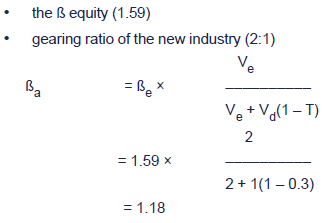
Step 2 - Adjust the asset beta to reflect the gearing levels of the company
Calculate the equity beta of the new project, byre-gearing:incorporate the financial risk of our company using ourgearing ratio (5:2)
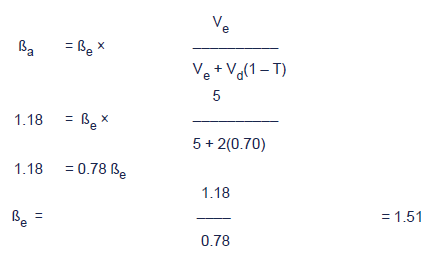
Step 3 - Use the re-geared beta to find the risk-adjusted Ke:
Calculate the cost of equity of the project based on CAPM:
Ke = RF + ß (RM –RF)
= 11% + 1.51 (16% – 11%) = 18.55%


 Test your understanding 6 – CAPM and gearing risk
Test your understanding 6 – CAPM and gearing risk
Hubbard, an all-equity food manufacturing firm, is about to embarkupon a major diversification in the consumer electronics industry. Itscurrent equity beta is 1.2, whilst the average equity ß of electronicsfirms is 1.6. Gearing in the electronics industry averages 30% debt, 70%equity.
Corporate debt is considered to be risk free.
Rm = 25%, Rf = 10%, corporation tax rate = 30%
What would be a suitable risk-adjusted cost of equity for the newinvestment if Hubbard were to be financed in each of the following ways?
(a)By 30% debt and 70% equity
(b)Entirely by equity.
(c)By 20% debt and 80% equity.
(d)By 40% debt and 60% equity.

 Suitable discount rates for the project should reflect both its systematic business risk and its level of gearing.
Suitable discount rates for the project should reflect both its systematic business risk and its level of gearing.
Chapter summary
Test your understanding answers

 Test your understanding 1 – Operating gearing
Test your understanding 1 – Operating gearing
Operating gearing can be calculated as follows:

Firm B carries a higher operating gearing because it has higher fixed costs.
Its operating earnings will therefore be more volume-sensitive:

Firm B has enjoyed an increase in EBIT of 40% whilst Firm A has hadan increase of only 20%. In the same way a decrease in sales wouldbring about a greater fall in B's earnings than in A's.


 Test your understanding 2 – Capital and equity gearing
Test your understanding 2 – Capital and equity gearing
Solution

Note: strictly the overdraft is a short-term finance methodwhereas financial gearing looks at the mix of the company's medium tolong-term finance. Where however a company were to consistently operateat an overdraft then there is an argument for including the core amountof the overdraft in long-term debt.
If we assume the overdraft is short-term finance, then the ratios become:



 Test your understanding 3 – The impact of financial gearing
Test your understanding 3 – The impact of financial gearing
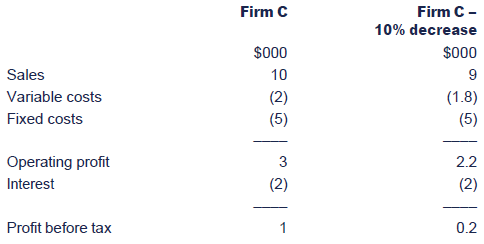
The impact of a 10% decrease in sales has reduced operating earnings by (3 – 2.2)/3 = 26.67%.
The increased volatility can be explained by the high operating gearing in C.
However, C also has debt interest obligations. This financialgearing has the effect of amplifying the variability of returns toshareholders. The 10% drop in sales has caused the overall return tofall by (1 – 0.2)/1= 80%. The additional 53.33% variation over andabove the change in operating earnings is due to the use of debtfinance.


 Test your understanding 4 – Gearing theories
Test your understanding 4 – Gearing theories
(a)The WACC will remain the same M&M – no tax (see above).
(b)Because the returns toshareholders become more volatile. (Note: this is not just an M&Mview but true of all the approaches to gearing).
(c)The company which had geared up M&M – with tax (see above).
(d)Debt Pecking-order theory (see 5 above).


 Test your understanding 5 – CAPM
Test your understanding 5 – CAPM

Thus the project is worthwhile because its expected rate of returnis higher than its minimum required return. This again assumes investorswill not want any returns to compensate for the unsystematic risk onthe new project, i.e. that they have well diversified portfolios.
Alternatively, the NPV of the project at its minimum required return is:

The NPV shows the gain made by the shareholders if the project is accepted.


 Test your understanding 6 – CAPM and gearing risk
Test your understanding 6 – CAPM and gearing risk
In all four situations the best approach is to treat the project asa 'mini-firm' and tailor the discount rate to reflect its level ofsystematic business risk and financial risk.
(a)By 30% debt and 70% equity
In this case the observed equity beta of the electronics industrywould reflect the level of business risk and financial risk of theproject. No adjustments are therefore required and the average equity βof the electronics industry can be used.
We can therefore jump straight to step (3), using the correct equity beta to find Ke

(b)Project financed entirely by equity
To reflect the business risk of the new venture we should start with the equity β of the electronics industry, i.e. 1.6.
As our project is to be ungeared we should then remove the financial risk element:

The risk-adjusted cost of equity would then be:
Ke = Rf + β (Rm − Rf)
= 10% + 1.23 (25% − 10%)
= 28.45%
The project should be evaluated at a rate of 28.45%.
(c)Project financed by 20% debt and 80% equity
In this case the equity beta of the electronics industry reflects ahigher level of gearing than that for the proposed project. Thesimplest procedure is to take a two-step approach to the gearingadjustment.
Step 1 Calculate the asset beta for the electronics company (as in (b)).
β asset = 1.23
This is a measure of the pure systematic risk of electronicscompanies. We now adjust this pure beta in the light of the givenfinancial gearing ratio.
Step 2 Work out the equation 'backwards' to calculate the cost of equity for an electronics company with 80% equity and 20% debt.

(d)Project financed by 40% debt and 60% equity
In this case the equity beta of the electronics industry reflects alower level of gearing than that for the proposed project. The processis the same seen in part (c).
Step 1 Calculate the asset beta for the electronics company (as in (b)).
β asset = 1.23
Step 2 Work out the equation 'backwards' to calculate the cost of equity for an electronics company with 60% equity and 40% debt.
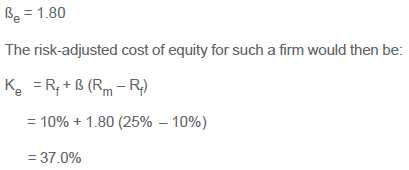

|
Created at 5/24/2012 4:19 PM by System Account
(GMT) Greenwich Mean Time : Dublin, Edinburgh, Lisbon, London
|
Last modified at 5/25/2012 12:54 PM by System Account
(GMT) Greenwich Mean Time : Dublin, Edinburgh, Lisbon, London
|
|
|
|
 |
Rating
:
|
 Ratings & Comments
(Click the stars to rate the page) Ratings & Comments
(Click the stars to rate the page)
|
 |
Tags:
|
|
|
|
|